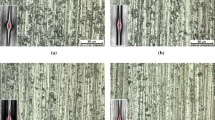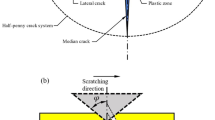Abstract
The surface quality and subsurface damage (SSD) distribution achieved with a fine-grained grinding wheel under different depth-of-cut and cutting speed is experimentally studied. The ground surface roughness (SR) is investigated via white light interferometry and expressed in terms of four typical roughness values (PV, RMS, Rz, and Ra). The SSD is characterized by the magnetorheological finishing (MRF) spot method and transmission electron microscopy. The results show that brittle-ductile surfaces and ductile-like surfaces are generated during ultra-precision grinding. Largely due to plastic flow removal, fracture defects such as fractured pits and grinding streaks on the ground surface can be mitigated. Instead, a ductile-like surface covered with grinding streaks is found. When the depth-of-cut decreases from 4 to 1 μm, the SR and SSD depth decreases from PV 1.34 μm, Ra 15.23 nm, Rz 0.94 μm, RMS 22.24 nm, and SSD 6.1 μm to PV 0.51 μm, Ra 5.07 nm, Rz 0.24 μm, RMS 6.70 nm, and SSD 1.2 μm. In addition, when the cutting speed increases from 3.9 to 23.4 m/s, the SR and SSD depth decreases from PV 1.03 μm, Ra 15.01 nm, Rz 0.82 μm, RMS 21.43 nm, and SSD 5.6 μm to PV 0.12 μm, Ra 3.17 nm, Rz 0.07 μm, RMS 4.65 nm, and SSD 0.003 μm. Moreover, the material removal mechanism under different grinding parameters is revealed by calculating undeformed chip thickness, and the mechanism of surface morphology and subsurface crack produced in brittle-ductile mode is analyzed. A linear relationship between the SR and SSD depth is in accord with the formula SSD = 0.41Ra−0.68 for brittle-ductile surfaces.
















Similar content being viewed by others
Data and materials availability
Not applicable.
References
Campbell JH, Hawley-Fedder R, Stolz CJ, Menapace JA, Borden MR, Whitman P, Yu J, Runkel M, Riley M, Feit M, Hackel R (2004) NIF optical materials and fabrication technologies: an overview. Proceedings of SPIE. The International Society for Optical Engineering 5341. https://doi.org/10.1117/12.538471
Shi F, Shu Y, Song C, Tian Y, Tie G, Xue S, Xiao H (2020) Advances in shape controllable and property controllable manufacturing technology for ultraviolet fused silica components with high precision and few defects. High Power Laser and Particle Beams 32(3):032002. https://doi.org/10.11884/HPLPB202032.190399
Bude J, Miller P, Baxamusa S, Shen N, Laurence T, Steele W, Suratwala T, Wong L, Carr W, Cross D, Monticelli M (2014) High fluence laser damage precursors and their mitigation in fused silica. Opt Express 22(5):5839–5851. https://doi.org/10.1364/OE.22.005839
Miller P, Suratwala T, Bude J, Laurence T, Shen N, Steele W, Feit M, Menapace JA, Wong L (2009) Laser damage precursors in fused silica. Proceedings of SPIE the International Society for Optical Engineering 75040X. https://doi.org/10.1117/12.836986
Xu M, Dai Y, Zhou L, Shi F, Wan W, Xie X, Sui T (2016) Investigation of surface characteristics evolution and laser damage performance of fused silica during ion-beam sputtering. Opt Mater 58:151–157. https://doi.org/10.1016/j.optmat.2016.03.034
Li Y, Zheng N, Li H, Hou J, Lei X, Chen X, Yuan Z, Guo Z, Wang J, Guo Y, Xu Q (2011) Morphology and distribution of subsurface damage in optical fused silica parts: bound-abrasive grinding. Appl Surf Sci 257:2066–2073. https://doi.org/10.1016/j.apsusc.2010.09.051
Dumas P, Hall C, Hallock B, Tricard M (2007) Complete subaperture pre-polishing and finishing solution to improve speed and determinism in asphere manufacture. Proceedings of SPIE - The International Society for Optical Engineering 6671:1133–1148. https://doi.org/10.1117/12.734684
Lambropoulos JC, Li Y, Funkenbusch P, Ruckman J (1999) Non-contact estimate of grinding-induced subsurface damage. Proceedings of SPIE - The International Society for Optical Engineering 3782:41–50. https://doi.org/10.1117/12.369213
Randi JA, Lambropoulos JC, Jacobs SD (2005) Subsurface damage in some single crystalline optical materials. Appl Opt 44(12):2241–2249. https://doi.org/10.1364/AO.44.002241
Li S, Wang Z, Wu Y (2008) Relationship between subsurface damage and surface roughness of optical materials in grinding and lapping processes. J Mater Process Technol 205:34–41. https://doi.org/10.1016/j.jmatprotec.2007.11.118
Suratwala T, Wong L, Miller P, Feit M, Menapace J, Steele R, Davis P, Walmer D (2006) Sub-surface mechanical damage distributions during grinding of fused silica. J Non-Cryst Solids 352(52-54):5601–5617. https://doi.org/10.1016/j.jnoncrysol.2006.09.012
Li H, Yu T, Zhu L, Wang W (2016) Evaluation of grinding-induced subsurface damage in optical glass BK7. J Mater Process Technol 229:785–794. https://doi.org/10.1016/j.jmatprotec.2015.11.003
Jiang C, Cheng J, Wu T (2017) Theoretical model of brittle material removal fraction related to surface roughness and subsurface damage depth of optical glass during precision grinding. Precis Eng 49:421–427. https://doi.org/10.1016/j.precisioneng.2017.04.004
Blaineau P, Laheurte R, Darnis P, Darbois N, Cahuc O, Neauport J (2013) Relations between subsurface damage depth and surface roughness of grinded fused silica. Opt Express 21(25):30433–30443. https://doi.org/10.1364/OE.21.030433
Chen J, Fang Q, Li P (2015) Effect of grinding wheel spindle vibration on surface roughness and subsurface damage in brittle material grinding. Int J Mach Tool Manu 91:12–23. https://doi.org/10.1016/j.ijmachtools.2015.01.003
Fang F, Zhang N, Guo D, Ehmann K, Cheung B, Liu K, Yamamura K (2019) Towards atomic and close-to-atomic scale manufacturing. International Journal of Extreme Manufacturing 1:012001. https://doi.org/10.1088/2631-7990/ab0dfc
Brinksmeier E, Mutlugünes Y, Klocke F, Aurich JC, Shore P, Ohmori H (2010) Ultra-precision grinding. CIRP Ann Manuf Technol 59:652–671. https://doi.org/10.1016/j.cirp.2010.05.001
Abdulkadir LN, Abou-El-Hossein K, Jumare AI, Odedeyi PB, Liman MM, Olaniyan TA (2018) Ultra-precision diamond turning of optical silicon—a review. Int J Adv Manuf Technol 96:173–208. https://doi.org/10.1007/s00170-017-1529-x
Zhang S, To S, Wang S, Zhu Z (2015) A review of surface roughness generation in ultra-precision machining. Int J Mach Tool Manu 91:76–95. https://doi.org/10.1016/j.ijmachtools.2015.02.001
Onwuka G, Abou-EI-Hossein K (2016) Surface roughness in ultra-high precision grinding of BK7. Procedia CIRP 45:143–146. https://doi.org/10.1016/j.procir.2016.03.023
Ohmori H, Umezu S, Kim Y, Uehara Y, Kasuga H, Kato T, Itoh N, Kurokawa S, Kusumi T, Sugawara Y, Kunimura S (2020) A high quality surface finish grinding process to produce total reflection mirror for x-ray fluorescence analysis. International Journal of Extreme Manufacturing 2:015101. https://doi.org/10.1088/2631-7990/ab7a29
Gao S, Zhu L, Kang R, Guo D, Wang Z, Zhang B (2017) Surface/subsurface damage and material removal mechanism of glass-ceramics induced by ultra-precision grinding. Journal of Mechanical Engineering 53(7):180–187. https://doi.org/10.3901/JME.2017.07.180
Zhao Q, Liang Y, Stephenson D, Corbett J (2007) Surface and subsurface integrity in diamond grinding of optical glasses on Tetraform ‘C’. Int J Mach Tool Manu 47:2091–2097. https://doi.org/10.1016/j.ijmachtools.2007.05.005
Gao S, Geng Z, Wu Y, Wang Z, Kang R (2019) Surface integrity of quartz glass induced by ultra-precision grinding. Journal of Mechanical Engineering 55(5):186–195. https://doi.org/10.3901/JME.2019.05.186
Bifano TG, Dow TA, Scattergood RO (1991) Ductile-regime grinding: a new technology for machining brittle materials. ASME Journal of Engineering Industry 113:184–189. https://doi.org/10.1115/1.2899676
Malkin S, Guo C (2008) Grinding Technology: Theory and Applications of Machining with Abrasives, 2nd edn. Industrial Press Inc., New York
Chen B, Guo B, Zhao Q (2015) An investigation into parallel and cross grinding of aspheric surface on monocrystal silicon. Int J Adv Manuf Technol 80:737–746. https://doi.org/10.1007/s00170-015-7045-y
Wang Z, Wu Y, Dai Y, Li S, Zhou X (2008) Rapid detection of subsurface damage of optical materials in lapping process and its influence regularity. Opt Precis Eng 16(1):16–21. https://doi.org/10.3321/j.issn:1004-924X.2008.01.004
Menapace J, Davis P, Steele W, Wong L, Suratwala T, Miller P (2006) MRF Applications: Measurement of Process-dependent Subsurface Damage in Optical Materials using the MRF Wedge Technique. Proceedings of SPIE - The International Society for Optical Engineering 5991:599103. https://doi.org/10.1117/12.638839
Acknowledgements
We thank LetPub (www.letpub.com) for its linguistic assistance during the preparation of this manuscript.
Funding
This research was funded by the National Natural Science Foundation of China (NSFC) (No. 51991374, No. 51835013, and No. U1801259), National Key R&D Program of China (No. SQ2020YFB200368-04), Strategic Priority Research Program of the Chinese Academy of Sciences (No. XD25020317), the Excellent Youth Project of Educational Committee of Hunan Province of China (No. 20B067) and the Science and Technology Innovation Program of Hunan Province (2020JJ5617).
Author information
Authors and Affiliations
Contributions
Conceptualization, Yifan Dai; Investigation, Yaoyu Zhong; Methodology, Yaoyu Zhong and Hang Xiao; Supervision, Yifan Dai and Feng Shi; Validation, Feng Shi and Hang Xiao; Visualization, Yaoyu Zhong; Writing, Yaoyu Zhong.
Corresponding author
Ethics declarations
Ethics approval and consent to participate
Not applicable.
Consent for publication
Not applicable.
Competing interests
The authors have no relevant financial or non-financial interests to disclose.
Additional information
Publisher’s note
Springer Nature remains neutral with regard to jurisdictional claims in published maps and institutional affiliations.
Rights and permissions
About this article
Cite this article
Zhong, Y., Dai, Y., Xiao, H. et al. Experimental study on surface integrity and subsurface damage of fused silica in ultra-precision grinding. Int J Adv Manuf Technol 115, 4021–4033 (2021). https://doi.org/10.1007/s00170-021-07439-y
Received:
Accepted:
Published:
Issue Date:
DOI: https://doi.org/10.1007/s00170-021-07439-y




